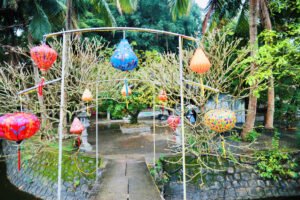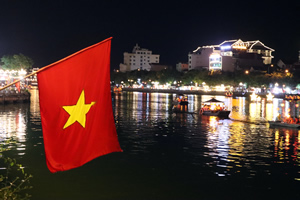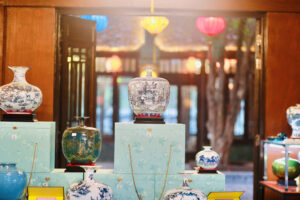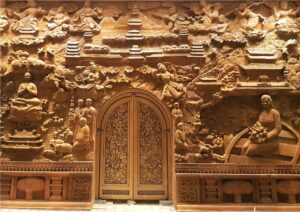A whimsical figure in Western culture, the Unicorn (Kỳ Lân) is one of the four mythical animals in the spiritual culture of the Vietnamese. Symbolizing peace, wealth and luck, it also represents intelligence and goodness. Additionally, this composite creature of horse, buffalo, and dragon is seen as a motif of strength and faithfulness, often depicted in stone to guard holy sites and temples.
However, in Vietnam it can also appear in a more “nightmarish” stylized form. Deer horns, dog ears, a camel forehead, devil eyes, a lion nose, a broad mouth, a horse body, deer hooves, and an oxtail are some of the deviations. Quite a difference from the elegant, single horned white horse of the west.
Kỳ Lân Mountain (Núi Kỳ Lân) is a well-known landmark in Ninh Binh. While “mountain” might be euphemistic for a 50 meter high natural stone protuberance, it apparently gets its name from the likeness of a Unicorn’s head facing north and a slope with a dip representing its jaws. Naturally, like most landmarks in Vietnam, there is a local legend to suit.
The Legend
In ancient times, a creature called the “black unicorn” troubled residents in the area. This malevolent beast frequently killed and ate local people, causing havoc and terror. Eventually driven to despair, the people decided that one of the king’s daughters would offer herself to the demon while secretly taking a slow-acting poison before the fateful meeting.
As expected, the black unicorn killed and ate the unfortunate princess, but by doing so, it poisoned itself and perished. As it laying dying in the moonlight, its corpse gradually blended with the rocky landscape, forming the mountain. Eventually trees, flowers, and grass grew luxuriantly around the hanging cliffs, eventually being seen as the beard of the vanquished unicorn.
Consequentially and In honor of the princess’s self-sacrifice, the people constructed a temple at the northwest foot of the mountain. An incense burner stands in front of the temple’s entrance door and on either side are two sculptures of “cranes standing on the back of a turtle”, signifying the noble harmony between heaven and earth. Inside the temple, there is altar for worship of the ancient princess, with a statue of the noble girl and her servants in the middle, surrounded by statues of the 5 Venerable Mandarins below.
Location
These days, people know Kỳ Lân Mountain as a popular meeting spot, filled with upmarket food and coffee shops, large “floating” pagodas built on the lakes themselves, paved walking paths, and even a Highlands café built into the mountain itself. The temple is only a short distance from the center of town, along side the busy National Highway 1A and at the beginning of Trang An Street area (the route eventually leading to tourist attractions such as Hoa Lu old capital, Trang An and Hang Mua viewpoint). The Trang An River, which connects to the “historic” Sao Khe River of Hoa Lu’s ancient capital, encircles it, with the Hoa Lu hotel adjacent and the twin towers of the Silver Pagodas standing behind.
While Kỳ Lân Mountain is modest in size, it is has 5 limestone caverns, each hidden in the lush green trees and foliage. To enter Kỳ Lân Mountain, there is picturesque small stone bridge barely wide enough for one person that spans the Trang An River at the northern foot of the mountain. Or visitors can choose the the 4m wide stone bridge on the south side, near the Hoa Lu hotel.
A number of paths track over and through the mountain, allowing visitors scenic views across the wide river. Of course ,there are the obligatory selfie spots but perhaps more importantly, a sublime chance to walk off those sugar laden cakes and caphe sua da consumed below. The twin “silver pagodas” have raised walkways across the water and are replete with stucco motifs of much of the area’s spiritual history. It is not hard to see why it is a popular spot with locals and tourists alike – especially on the weekends.
Getting Around
Following the walking path from the temple there is a stone corridor along the mountainside leading to the Ky Lân Pagoda at the summit of the mountain. Created in “one-pillar” architecture with a curving roof, statues of imperial guardian lions safeguard the little pagoda on both sides. Representing “two dragons flanking a moon” the pagoda gives homage to the strength of the gods. Inside, Buddha sculptures decorate the space, and a finely crafted large bronze bell serves as the centerpiece of this little pagoda
The tranquil panorama in a corner of the bustling city is a delight, capturing the vision of visitors from the top of the mountain with the golden color of the two Buddha towers behind and the green color of the trees gradually fusing “heaven and earth” together.
Bac Pagodas
The Bac (Silver) Pagoda towers are located on the lake in front of the Kỳ Lân Pagoda. The path is easy to find and cuts across the water at the narrow northern flank and is accessible using the little stone bridge mentioned earlier. Although newly built, the towering constructions form a majestic “wonder” that retains and celebrates modern Vietnamese Buddhism. Inside each Silver Pagoda is a Buddhist hall, with all of the murals carved entirely in volcanic stone by a team of artisans from Ninh Binh’s mountainous region.
As night falls, the lights on the twin towers are mirrored in the shadowed depths of the waters of the Trang An River. Along with the bustling beauty of Hoa Lu Old Town next door, the vibrant lights blend with the beauty of the “cold colors” of the moonlight while the rich beauty of Ninh Binh fills the air. To locals, it is like being “drunk” with a sip of strong wine, letting the wonder and awe of the centuries of human endeavor gradually take root in each person’s soul.
Modernization
From the mystical to the mundane, these days Ky Lan Mountain is a popular spot for locals to meet and greet. The Highland’s chain proudly places a well-appointed coffee shop at the side of the mountain and is surrounded by the lavishly refurbished paths and gardens. Across the small canal on the city side of the entrance are several high end restaurants and boutiques.
It may seem sacrilege but the Vietnamese are nothing if not a pragmatic people and the place still retains a calming, meditative vibe. And who doesn’t like their meditative state served with chilled caphe sua da and a thick slice of chocolate mud cake? Besides which, there are ancient temples to spare in Ninh Binh and one suspects even the Gods would forgive such a delightful reinterpretation.
Even If you are not into history or ancient temples, Ky Lan Mountain is a beautiful, relaxing spot and great for photography. It is also easy to find as it is on the main road out of town and an excellent spot to unwind after a hard day’s sightseeing. A caveat is that the main area usually shuts down around 7 to 8 pm in the evening and with the lights out and the crowds gone, Ky Lan returns to its mysteries and secrets.





